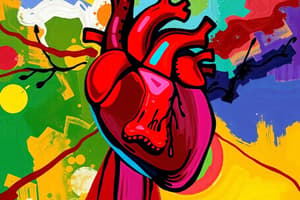Podcast
Questions and Answers
Describe diastole during the cardiac cycle.
Describe diastole during the cardiac cycle.
Diastole is a period of relaxation where the atria and ventricles fill with blood. The AV valves are closed to prevent backflow of blood.
What happens during atrial systole?
What happens during atrial systole?
Atrial systole is when the atria contract synchronously, pushing blood from the upper chambers into the lower chambers.
What is the cardiac cycle?
What is the cardiac cycle?
The cardiac cycle is a continuous sequence of events that ensures the heart functions efficiently to pump blood throughout the body.
Explain ventricular diastole and its phases.
Explain ventricular diastole and its phases.
What is the purpose of the atrioventricular (AV) valves during diastole?
What is the purpose of the atrioventricular (AV) valves during diastole?
What is the purpose of the atrioventricular valves opening during late ventricular diastole?
What is the purpose of the atrioventricular valves opening during late ventricular diastole?
How does atrial contraction contribute to the filling of the ventricles?
How does atrial contraction contribute to the filling of the ventricles?
Describe the event that marks the end of ventricular diastole and the beginning of ventricular systole.
Describe the event that marks the end of ventricular diastole and the beginning of ventricular systole.
When does the second heart sound, S2 or dub, occur during the cardiac cycle?
When does the second heart sound, S2 or dub, occur during the cardiac cycle?
Why are heart sounds crucial for medical professionals in assessing heart health?
Why are heart sounds crucial for medical professionals in assessing heart health?
Explain the importance of understanding the alternating phases of systole and diastole in the cardiac cycle.
Explain the importance of understanding the alternating phases of systole and diastole in the cardiac cycle.
How does the coordinated contraction and relaxation of the atria and ventricles contribute to the cardiac cycle?
How does the coordinated contraction and relaxation of the atria and ventricles contribute to the cardiac cycle?
Flashcards are hidden until you start studying
Study Notes
Cardiac Cycle
The cardiac cycle is a continuous sequence of events that ensures the heart functions efficiently to pump blood throughout the body. It is characterized by alternating periods of contraction and relaxation of the atria and ventricles. This process begins with the atria and ventricles in a relaxed state, marking the start of diastole.
Diastole
During diastole, the atria and ventricles are in a state of relaxation, allowing them to fill with blood. The atria passively fill during atrial diastole, with blood entering from the superior and inferior vena cava and the pulmonary veins. Blood from the body enters the right atrium, while the left atrium fills from the pulmonary veins. The atrioventricular (AV) valves remain closed during this phase, preventing backflow of blood out of the atria.
Atrial Contraction
Atrial systole occurs after atrial diastole, where the atria contract synchronously, forcing any residual blood from the upper chambers into the lower chambers. This contraction increases atrial pressures, which in turn aids in the filling of the ventricles.
Ventricular Diastole
Ventricular diastole is further divided into three phases: early, middle, and late. During early ventricular diastole, both the atrioventricular and semilunar valves are closed, and blood flows into the ventricles. Pressure within the ventricles remains constant during this phase. In late ventricular diastole, the atrioventricular valves open, allowing blood to flow into the ventricles due to the pressure difference between the atria and ventricles.
Heart Sounds
During the cardiac cycle, two distinct heart sounds can be heard using a stethoscope. The first heart sound, also known as S1 or lub, occurs when the mitral and tricuspid valves close, marking the end of ventricular diastole and the beginning of ventricular systole. The second heart sound, S2 or dub, is heard when the semilunar valves close, indicating the completion of ventricular systole and the start of ventricular diastole. These sounds are crucial for medical professionals to assess heart health and function.
In conclusion, the cardiac cycle is a complex process involving the coordinated contraction and relaxation of the atria and ventricles. The alternating phases of systole and diastole ensure that blood is efficiently pumped throughout the body, maintaining proper circulatory function. Understanding these processes is essential for healthcare professionals and patients alike, as it provides valuable insights into the workings of the heart and the impacts of various cardiac conditions.
Studying That Suits You
Use AI to generate personalized quizzes and flashcards to suit your learning preferences.



